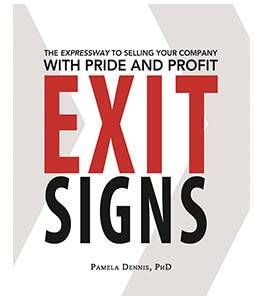Sell Your Business for Top Dollar
The author of 'Exit Signs' says these are the first three steps
(The following article is adapted from the new book, Exit Signs: The Expressway to Selling Your Business With Pride and Profit.)
If you own a business and you’re in your 50s or 60s, you’re likely relying on the sale of it to fund your retirement. Yet the company you’ve spent a lifetime building and growing faces its toughest competition.
U.S. Census data tell us that the group of business owners 70 years old or older is growing at a staggering rate, from about 20,000 owners each year in 2005 to over 120,000 today. And Capitalize Network, a business-transition planning service, estimates it’ll grow to over 180,000 a year in 2025. What’s more, in five or 10 years, the number of businesses for sale will be in the millions.
That’s why you need to develop an exit strategy.
But nine in 10 business owners don’t have a written, up-to-date exit plan, according to the White Horse Advisors Survey of Closely-Held Business Owners. Lack of planning is the No. 1 reason private business sales fail to meet the owners’ objectives.
Even sellers who look forward to exiting may dread the selling process or procrastinate. Some see it as a sign of growing old or losing self-worth. One owner told me: “At least when you die, you don’t have to think about what you are going to do the next day.”
Those who do successfully sell overwhelmingly wish they had started planning earlier. That means two to four years before you want to leave.
So how can you best realize your return when it’s time to sell? Here are three ways:
1. Be honest with yourself Do you really want to sell? Be clear about your answer or you will waste time and money on advisers, distract your people and rattle customers.
One COO of a mid-size company spent two years preparing and marketing the company for sale. Repeatedly, with a prospective buyer, the CEO/founder couldn’t pull the trigger, because he “just wasn’t emotionally ready.”

2. Be clear about your goals What do you most care about when you think about leaving your business?
Do you know, for example, your desired future lifestyle, financial needs and tax/estate strategies and your post-departure hopes for your business?
List your goals and force-rank them. Making the list starts to clarify your rational thinking; force-ranking helps clarify the emotions behind it.
In other words, what’s keeping you awake at night or stuck is not the list, but trying to know what’s critical to you.
3. Do a reality check on your business When selling your car, you take a hard look at what will help it sell fast and at a fair price.
Similarly, a business reality check looks at your company’s operational and organizational health to see where a tune-up is needed to improve its value and salability.
The first set of realitycheck factors are quantifiable operational aspects, including:
- Financial and operating efficiencies
- Customer base and revenue forecasts
- Assets including product pipelines and intellectual property
Wise business owners also have a second list of qualitative organizational factors that enhance sustainable value:
- Culture and strategy
- Execution discipline
- Leadership alignment
- Talent pool
While you intuitively know your strengths, a hard-nosed assessment of the factors in salability and sustainable value makes the priority tune-up issues clear and urgent.
The Two Toughest Questions
When asked why they don’t have an exit plan, owners typically give one or more of these three reasons: I’m too busy growing my company; it’s too early and I don’t want to think about it. Underlying these answers are two tough questions: Who am I if not my company? and What comes next?
Resolving these questions requires digging deep.
Understanding your feelings about leaving your business is a key to leaving it well. If you can’t imagine moving out of the past and into the future, you will lack the fuel to power decisions and activities for building that exit plan, handing over the keys and leaving.
Just as you had a dream when you started and built your company, you have to re-imagine the dream of life after it.
As one owner told me, he “left the baby he loved to experience the life he loved.”


